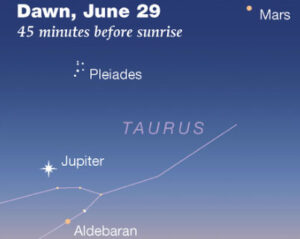Special to CosmicTribune.com, June 24, 2024
Excerpts from weekly Sky&Telescope report.
MONDAY, JUNE 24
■ After dark look south for orange Antares, “the Betelgeuse of summer,” nearing the meridian. (Both are 1st-magnitude “red” supergiants). Around and upper right of Antares are the other, whiter stars of upper Scorpius, forming their distinctive pattern.
■ Also right after dark, spot Arcturus way up high toward the south. Three fists below it is Spica.
 TUESDAY, JUNE 25
TUESDAY, JUNE 25
■ This is the time of year when the two brightest stars of summer, Arcturus and Vega, are about equally high overhead shortly after dark: Arcturus toward the southwest, Vega toward the east.
Arcturus and Vega are 37 and 25 light-years away, respectively. They represent the two commonest types of naked-eye star: a yellow-orange K giant and a white A main-sequence star. They’re 150 and 50 times brighter than the Sun, respectively — which, combined with their nearness, is why they dominate the evening sky.
WEDNESDAY, JUNE 26
■ Saturn and the waning gibbous Moon rise at nearly the same time around midnight tonight. Saturn will be about 5° or 6° left of the Moon.
By dawn Thursday morning they’ll be high in the southeast, drawing closer together.
The Moon will go on to occult Saturn in broad daylight Thursday for most of the western US and Mexico (map and timetables), but Saturn has such a low surface brightness (being almost 10 a.u. from the Sun), and the Moon and Saturn will be so much lower in the sky than the Sun, that you almost certainly won’t be able to glimpse a trace of Saturn even with a large telescope. New Zealanders, however, get to see the occultation in darkness (around 13h June 27th UT).
THURSDAY, JUNE 27
■ More on Arcturus and Vega: Star colors are mostly subtle, and different people have an easier or harder time seeing them. To me, the tints of bright stars show a little better on a late-twilight sky background than in a fully dark sky.
For instance, Vega is white with just a touch of icy blue. Arcturus is yellow-orange.
FRIDAY, JUNE 28
■ High in the east, the Summer Triangle holds sway after dark. Its top star is Vega, the brightest on the whole eastern side of the sky. The brightest star to Vega’s lower left is Deneb. Farther to Vega’s lower right is Altair.
With the Moon gone, you can see the Milky Way (if you’re not too light-polluted) running grandly just inside the Triangle’s bottom edge. This stretch of the Milky Way includes the Cygnus Star Cloud, one of its richest regions. Because when we look toward Cygnus, we’re looking downstream through the local arm of our galaxy.
As evening grows late and even Altair rises high, look left of Altair, by hardly more than a fist, for the compact little constellation Delphinus, the Dolphin.
Did you get it? Then try for even fainter, smaller Sagitta, the Arrow. It’s to Altair’s upper left a little closer to it. The Arrow points toward lower left, past the head of Delphinus.

■ The last-quarter Moon (exactly last quarter at 5:53 p.m. EDT) rises late tonight, at about 1 a.m. local daylight-saving time. Watch for it to come up below the Great Square of Pegasus. Saturn is about two fists at arm’s length to the Moon’s upper right. By the time dawn begins, you can see that the Moon is not quite halfway between Saturn and Mars.
Far lower left of Mars, Jupiter has been getting higher and easier low in the dawn. Welcome it into its 2024-25 apparition.
SATURDAY, JUNE 29
■ After nightfall, look for the Big Dipper hanging straight down in the northwest. Its bottom two stars, the Pointers, point to the right toward modest Polaris, the end of the Little Dipper’s handle.
This is the time of year when, at the end of twilight, the Little Dipper floats straight upward from Polaris Through light pollution or moonlight, however, all you may see of the Little Dipper are Polaris at its bottom and Kochab, the lip of the Little Dipper’s bowl, at the top. The rest of its stars are fairly dim at 3rd to 5th magnitude.
SUNDAY, JUNE 30

If you examine the WNW horizon in bright twilight day by day, when will first pick up Mercury? Venus?
■ Dangling lower right from bright Vega high in the east are the main stars of Lyra, forming a small triangle and parallelogram. The two brightest stars of this pattern after Vega are the two forming the bottom of the parallelogram: Beta and Gamma Lyrae, or Sheliak and Sulafat. They’re currently lined up vertically. Beta is the one on top.
Beta Lyrae is an eclipsing binary. Compare it to Gamma whenever you look up at Lyra. Normally Beta is only a trace dimmer than Gamma. Eventually, however, you’ll catch Beta when it is quite obviously dimmer than usual.

You must be logged in to post a comment Login